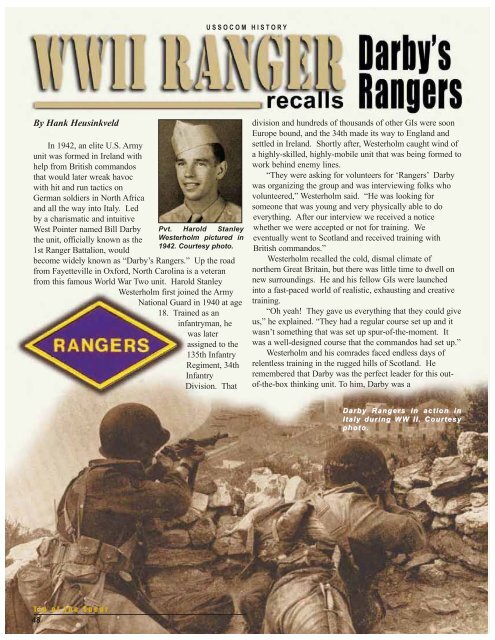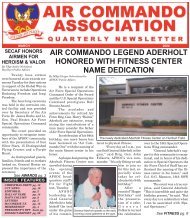tip of the spear (pdf) - The Air Commando Association
tip of the spear (pdf) - The Air Commando Association
tip of the spear (pdf) - The Air Commando Association
You also want an ePaper? Increase the reach of your titles
YUMPU automatically turns print PDFs into web optimized ePapers that Google loves.
By Hank Heusinkveld<br />
In 1942, an elite U.S. Army<br />
unit was formed in Ireland with<br />
help from British commandos<br />
that would later wreak havoc<br />
with hit and run tactics on<br />
German soldiers in North Africa<br />
and all <strong>the</strong> way into Italy. Led<br />
by a charismatic and intuitive<br />
West Pointer named Bill Darby<br />
<strong>the</strong> unit, <strong>of</strong>ficially known as <strong>the</strong><br />
1st Ranger Battalion, would<br />
Pvt. Harold Stanley<br />
Westerholm pictured in<br />
1942. Courtesy photo.<br />
become widely known as “Darby’s Rangers.” Up <strong>the</strong> road<br />
from Fayetteville in Oxford, North Carolina is a veteran<br />
from this famous World War Two unit. Harold Stanley<br />
Westerholm first joined <strong>the</strong> Army<br />
National Guard in 1940 at age<br />
18. Trained as an<br />
infantryman, he<br />
was later<br />
assigned to <strong>the</strong><br />
135th Infantry<br />
Regiment, 34th<br />
Infantry<br />
Division. That<br />
Tip <strong>of</strong> <strong>the</strong> Spear<br />
48<br />
USSOCOM HISTORY<br />
division and hundreds <strong>of</strong> thousands <strong>of</strong> o<strong>the</strong>r GIs were soon<br />
Europe bound, and <strong>the</strong> 34th made its way to England and<br />
settled in Ireland. Shortly after, Westerholm caught wind <strong>of</strong><br />
a highly-skilled, highly-mobile unit that was being formed to<br />
work behind enemy lines.<br />
“<strong>The</strong>y were asking for volunteers for ‘Rangers’ Darby<br />
was organizing <strong>the</strong> group and was interviewing folks who<br />
volunteered,” Westerholm said. “He was looking for<br />
someone that was young and very physically able to do<br />
everything. After our interview we received a notice<br />
whe<strong>the</strong>r we were accepted or not for training. We<br />
eventually went to Scotland and received training with<br />
British commandos.”<br />
Westerholm recalled <strong>the</strong> cold, dismal climate <strong>of</strong><br />
nor<strong>the</strong>rn Great Britain, but <strong>the</strong>re was little time to dwell on<br />
new surroundings. He and his fellow GIs were launched<br />
into a fast-paced world <strong>of</strong> realistic, exhausting and creative<br />
training.<br />
“Oh yeah! <strong>The</strong>y gave us everything that <strong>the</strong>y could give<br />
us,” he explained. “<strong>The</strong>y had a regular course set up and it<br />
wasn’t something that was set up spur-<strong>of</strong>-<strong>the</strong>-moment. It<br />
was a well-designed course that <strong>the</strong> commandos had set up.”<br />
Westerholm and his comrades faced endless days <strong>of</strong><br />
relentless training in <strong>the</strong> rugged hills <strong>of</strong> Scotland. He<br />
remembered that Darby was <strong>the</strong> perfect leader for this out<strong>of</strong>-<strong>the</strong>-box<br />
thinking unit. To him, Darby was a<br />
Darby Rangers in action in<br />
Italy during WW II. Courtesy<br />
photo.



